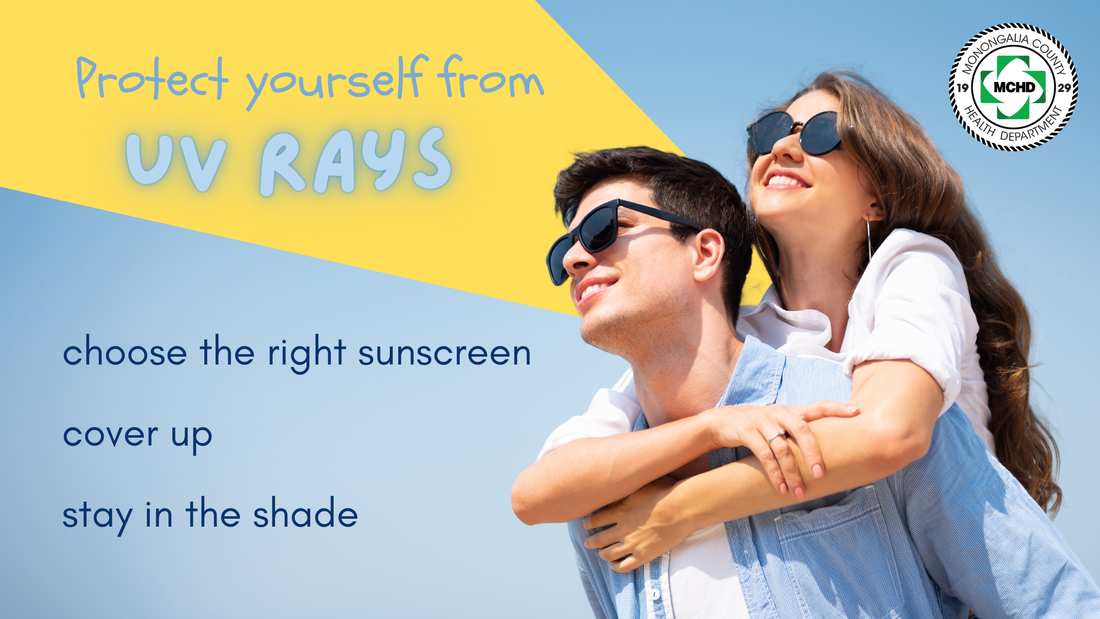Beat the heat by protecting yourself from UV rays

Jul. 8, 2022
By Katie Minor
It’s summer and we can all feel the heat! This is the best time of year to get out and experience the beauty our county has to offer, so you want to be sure you’re taking all the proper precautions in the sun.
July is Ultraviolet (UV) Safety Month. There are lots of dangers that come with overexposure to UV rays. Along with things like leathery skin and weakened immune systems, prolonged exposure to UV rays can cause most skin cancers.
And as skin cancer is the most diagnosed cancer in the United States than all other cancers combined, it’s important to take extra precautions to keep our skin healthy and UV-exposure safe.
There are three main types of UV rays: UVA, UVB and UVC. So it’s good to know your UV-ABCs. Here are the basics:
- UVA rays can cause damage to skin cells and DNA. UVA rays are commonly associated with causing wrinkles, aging of the skin and some cancers.
- UVB rays can cause more damage to the skin than UVA rays. UVB rays cause direct damage to the skin and are the main cause for sunburns. They are believed to cause most skin cancers.
- UVC rays have more energy in them than any other UV rays. However, they are not located within our atmosphere or sunlight. UVC rays normally aren’t associated with causing skin cancer.
In order to protect yourself from the sun’s harmful rays, follow these tips:
- Choose the right sunscreen. The U.S. Food and Drug Administration (FDA) recommends that each person wears sunscreen that has a sun protection factor (SPF) that is at least 15 — and higher for those who are more at risk — and they should cover UV-A and UV-B rays.
- Cover up. If you are going to be out in the sun, you should wear proper clothing such as pants, long-sleeved shirts, a hat and sunglasses to protect you from harmful rays.
- Stay in the shade. Because midday is when the sun is at its most intense, try staying in a shaded area from 10 a.m. to 4 p.m. to help protect your skin.
- Avoid tanning beds. Tanning beds give off a large amount of UVA rays and can increase skin cancer risks and premature aging.
According to the American Academy of Dermatology Association, a tan is a sign that your skin has been injured. Whether the tan was from exposure to UV rays from a tanning bed or the sun, every time your skin tans, it’s a result of being harmed. Increased harm to your skin can cause premature aging and increase risk for skin cancers.
Being aware of what the beginning stages of skin cancer may look like can help avoid spreading, making it much easier to treat. Conducting your own skin check once a month is also recommended. Use a hand held and full-length mirror to look at areas that are hard to see in a well-lit room.
The American Cancer Society suggests using the “ABCDE rule” to look for some common signs of melanoma, which is considered to be one of the deadliest forms of skin cancer.
- Asymmetry: A benign mole is generally symmetrical; a malignant mole will have one side that doesn’t match the other.
- Border: The edges are irregular, ragged, notched or blurred.
- Color: The color is not the same all over and may include shades of brown, black, sometimes with patches of pink, red, white or blue.
- Diameter: The spot is larger than one-fourth inch across — about the size of a pencil or eraser.
- Evolving: The mole is changing in size, shape or color.
If you have any concerns about moles or spots you’ve found on your body, we recommend setting up an appointment with your dermatologist as soon as possible. It also doesn’t hurt to just get checked out by a dermatologist, because we can’t easily see all parts of our body.
With beautiful parks, swimming pools and community events, there’s lots to do outside in Monongalia County this summer. By taking these precautions, the rest of your summer can be fun and safe!
Katie Minor is a public information office assistant at Monongalia County Health Department.